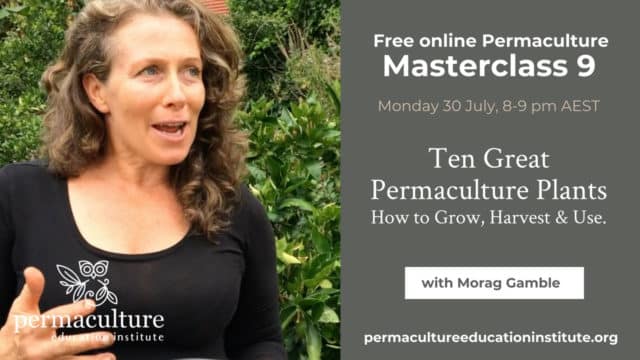What are your favourite permaculture plants – the ones that really bring structure and substance to your edible landscape ecology?
I have so many, but there are a few that I find so absolutely invaluable in providing an abundance and resilience in my permaculture garden, and I appreciate them for this.
Check out my latest online permaculture masterclass: 10 Great Permaculture Plants – How to Grow, Harvest and Use . I share a lot about how to make the best use of these permaculture plants in your design and how to care for and use these plants in a multiplicity of ways.
These 10 permaculture plants I talk about in this Masterclass contribute to:
- diverse abundant food
- natural medicine
- great teas
- excellent dyes
- animal food
- wildlife habitat
- pollinator food
- shade and protection for ‘pest’ helpers
- mulch and living mulches
- organic matter, soil food
- microclimate moderation
- low water use garden
- low maintenance garden
- low pest garden
- and more

Canna edulis
My youtube clips about some of these permaculture plants
To follow up from the permaculture plants explored in the film, you might be interested in taking a look at these youtube clips I have created.
- Pumpkin
- 7 ways to use all your pumpkin (blogpost)
- Comfrey
- How to Make Comfrey Tea
- How to make pesto with society garlic
- Aloe Vera
- Turmeric
- Pigeon Pea
- Sacred Basil
- Mustard Spinach
- Collecting mustard spinach seeds

Comfrey



Another great Masterclass, Morag. My only disappointment was that I already have all of these, but it’s great to know I’m on the right track 😀
I would add galangal to your list. I love using it to teach people about multiple functions. The roots are a child-friendly version of ginger and an essential element in many Thai curry mixes. They’re also great either fermented or fresh pickled. The leaves are another chop-and-drop but not as tall as arrowroot. The flowers are a traditional flavouring for sticky rice and will also scent a whole room without the need for synthetic ‘air freshener’. Like all members of the ginger family, it’s also medicinal and great for improving digestion or reducing inflammation.
My green mustard seems to have cross bred (tokyo bekuna, Amish deer tongue and bok choy are all possibilities) and now I have this diverse collection of interesting leafy greens that range from spicy to mild and happily self seed.
Best of luck with the subscription course. I’d love to do it but can’t really justify ANOTHER PDC 😀 I’m sure it’s brilliant.